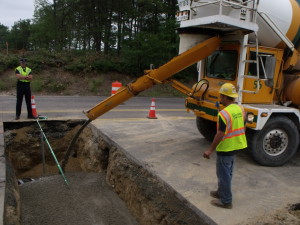Flowable Fill-Crete
Flowable Fill
The versatile “liquid soil” which is placed as a flowable liquid, yet hardens and rapidly develops excellent load-bearing properties with no compaction necessary.
Flowable fill was initially developed over 20 years ago as a solution to reoccurring problems originating from poorly compacted soil or granular fill. Over the past decade, extensive research and technology advancement with flowable fill mixtures has led to its use in numerous applications. These include:
- bedding and backfill for utility trenches
- paving subbase
- bridge abutment
- retaining wall backfill
Need a reason to consider flowable fill? Try one of these:
- Offers numerous cost advantages.
There are many monetary cost advantages, but one often overlooked advantage is worker safety. No one ever wants to have a worker injured on the job, and flowable fill can help by keeping the workers “out of the trenches,” literally! - Readily available
Ready-mixed concrete producers, using locally available materials, can produce flowable fill to meet project specifications. - No settlement
Flowable fill does not form voids during placement, and won’t settle or rut under loading. This advantage is especially significant if the backfill in a utility trench is to be covered by a pavement patch. Soil or granular fill, if not consolidated properly, may settle after a pavement patch is placed and forms cracks or dips in the road. - Easy to deliver
Ready-mix trucks can deliver specified quantities of flowable fill to the job site whenever the material is needed. - Versatile
Flowable fill mix designs can be adjusted to meet specific requirements and a variety of performance characteristics. - Improves worker safety
Workers can place flowable fill in a trench without entering the trench, reducing their exposure to possible cave-ins. - Easy to place
Depending on the type and location of void to be filled, flowable fill can be placed by chute, conveyor, pump, or bucket. Because flowable fill is self-leveling, it needs little or no spreading or compacting. This speeds construction and reduces labor requirements. - Allows fast return to traffic
Because flowable fill can be placed quickly and can support traffic loads within several hours, it minimizes road closures for pavement repairs. - Strong and durable
Load-carrying capacities of flowable fill typically are higher than those of compacted soil or granular fill. - Can be excavated
Flowable fill, having a compressive strength of less than 150 psi, is excavatable with conventional excavating equipment, yet is strong enough for most backfilling needs. - Requires less inspection
During placement, soil backfill must be tested after each lift for sufficient compaction. Flowable fill self-compacts consistently and doesn’t require this extensive field testing. - Reduces excavation
Flowable fill allows narrower trenches because it eliminates having to widen trenches to accommodate compaction equipment and laborers in the trench. - Reduces equipment needs
Unlike soil or granular backfill, flowable fill can be placed without rollers, loaders, or tampers. - Requires no on-site storage
Because ready-mix trucks deliver flowable fill to the job site in the quantities needed, storing fill material onsite is unnecessary. Also, there is no leftover fill to haul away. - Allows all-weather construction
Flowable fill will displace standing water left in a trench from rain or melting snow, eliminating the need for dewatering pumps. To place flowable fill in cold weather, the material temperature can be altered using the same methods in heating ready-mixed concrete.
Links to additional info on flowable fill: http://www.flowablefill.org/index.html

